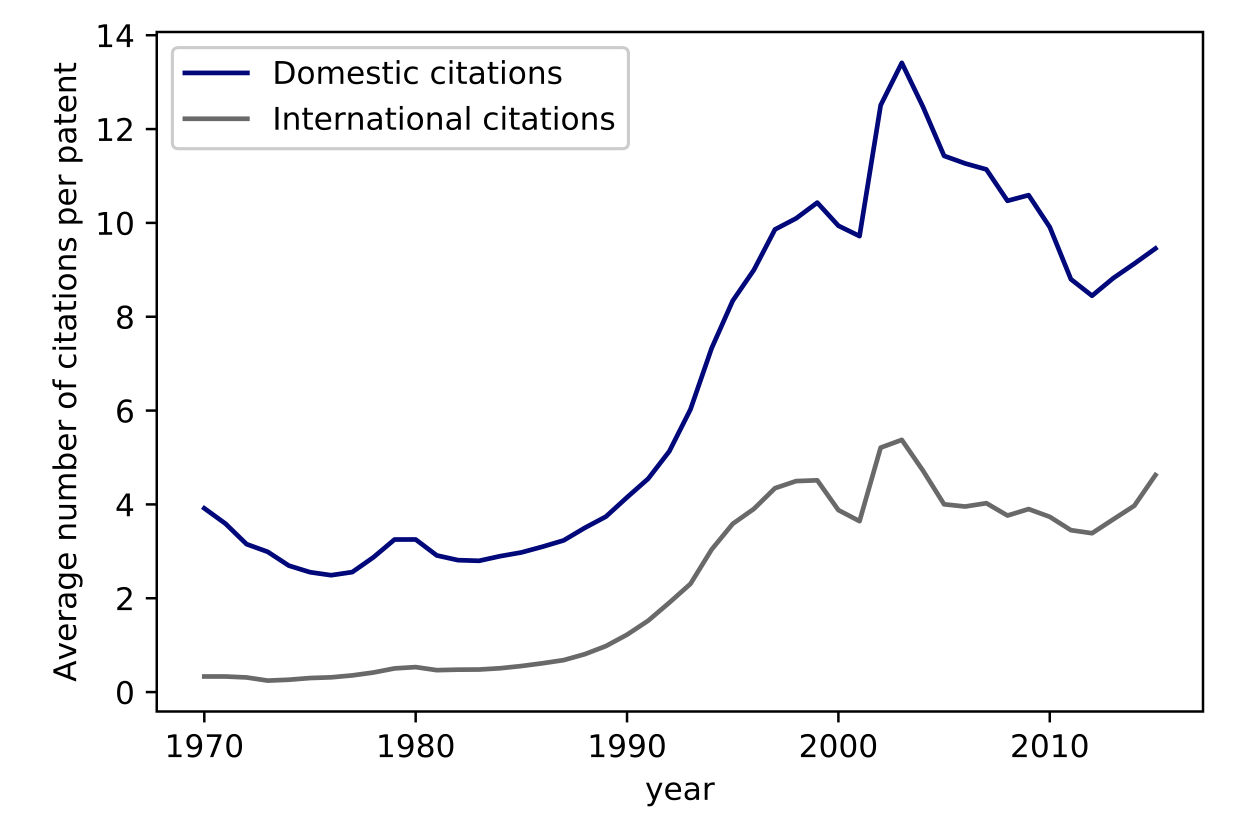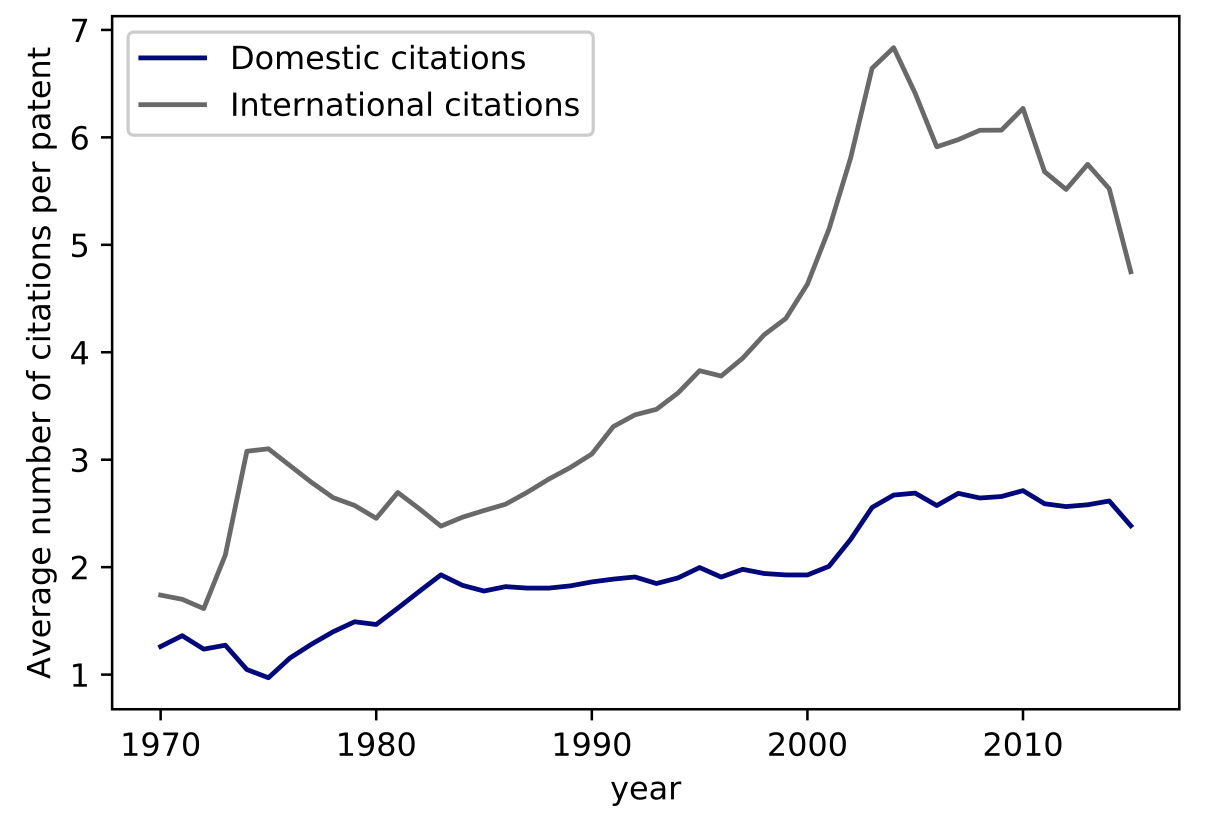The creation and adoption of new technologies are at the heart of modern economic growth. For example, Clark and Feenstra (2003) and Klenow and Rodríguez-Clare (1997) find that the majority of the divergence in income per capita over the 20th century can be attributed to cross-country differences in total factor productivity (TFP) growth. This finding is consistent with the insights of endogenous growth theory, which emphasizes innovation and idea generation as the central drivers of productivity and, ultimately, of economic growth (e.g. Romer 1990 and Aghion and Howitt 1992). Likewise, the process of idea diffusion across countries is key to explaining both the evolution of the global income distribution and the extent to which new innovations can build on existing foreign knowledge (see e.g. the discussion of knowledge spillovers in Keller 2002, Melitz and Redding 2021).
Perhaps surprisingly – and despite the importance that economists confer on innovation to account for the evolution of cross-country income per capita differences – direct measures of innovation covering a range of technologies, countries, and time periods are scant. Instead, a large body of work has focused on the analysis of technology diffusion for a relatively small number of technologies and countries (e.g. Gort and Klepper 1982). A notable exception is the work in a series of papers by Comin and Hobijn (2004, 2009a, 2010), Comin et al. (2008), and Comin and Mestieri (2018). These authors, building on the CHAT dataset (Comin and Hobijn 2009b), use direct measures of technology adoption to document slow diffusion across countries for a number of major technologies, and demonstrate the importance of technology diffusion in accounting for the evolution of the cross-country distribution of income per capita. While extremely useful by virtue of looking at direct technology measures, this literature faces the limitation of obtaining detailed, granular measures of technology diffusion.
In a recent paper (Berkes et al. 2022), we propose an alternative approach to document the evolution of innovation across time and space and study its effects on productivity using granular data on innovation. Our empirical analysis leverages rich historical patent data covering a large set of countries over the past century with detailed information on patent characteristics – an approach that has already proven useful in studies focusing on recent decades and a smaller set of countries, such as Pezzoni et al. (2019) and Bloom et al. (2021). The richness of our data provides a unique opportunity to measure the network of knowledge spillovers at the global level as proxied by patent citations. We leverage this network to estimate the causal effect of innovation induced by international spillovers on sectoral output per worker and TFP growth in a panel of country-sectors from 2000 to 2014, as well as on long-run aggregate income per capita since 1960.
Evolution of innovation across time and space
We build our measure of innovation using patent data collected from the European Patent Office Worldwide Patent Statistical Database (PATSTAT), which contains bibliographical and legal status information on more than 110 million patents from the world’s main patent offices, in both industrialised and developing countries. Based on the premise that knowledge is embedded in inventors, we first classify patents into ‘fields of knowledge’ with a machine-learning approach. This novel classification, available from the authors’ website, addresses the concern that patents belonging to different broad patent technology classes are related and capture the same type of innovations (Keller 2002).
Moreover, to avoid double-counting patents that are filed in more than one patent office, we restrict our analysis to patents that are the first in their (DOCDB) family; to control for patent quality, we weight them by total citations received by the patent family.
Armed with our newly defined technology classes, we show that their significance in the innovation space – as measured by the share of patents across fields of knowledge – has evolved over time (Figure 1). Two facts are noteworthy. First, we document a substantial increase in the concentration of innovation, especially around the 1990s. Approximately 10% of the fields of knowledge account for 60% of all patent activity in the 2000s, compared with 30% in the first half of the 20th century. Second, we find substantial heterogeneity in the evolution of fields of knowledge over time, with the fields ‘Digital Information and ‘Computing, Calculating’ the most prominent since the 2000s.
Figure 1 Evolution of top fields of knowledge
Notes: This figure represents the share of each field of knowledge, measured by the number of first-in-the-family patents weighted by backward citations, in total patent activity across all fields in a given period. The width of the coloured bars reflects the share of the knowledge field.
We then show that while advanced economies account for the bulk of patenting activity, there is substantial variation in terms of countries’ specialisation across fields of knowledge. Moreover, these patterns of specialisation are heterogeneous over time (Figure 2). Specifically, we focus our attention on the period from 1970 to 2015, for which we have available data for almost all countries. We document that throughout this period, there are two clear technological leaders in the top fields of knowledge: Japan and the US. At the same time, after 1995, European countries experience a decrease in importance in the innovation landscape, while some Asian countries, such as South Korea, start rising to the forefront of the technological frontier.
Figure 2 Countries shares in top fields, 1970–2015
Finally, we turn our attention to knowledge spillovers. While most of the existing literature focuses on local knowledge spillovers, or spillovers across a limited number of countries (e.g. Hanlon and Jaworski 2020, Liu and Ma 2021), we extend our analysis to the global level. We measure knowledge spillovers through patent citations across fields of knowledge and across countries. We show that for the average patent, citations tend to be biased towards domestic – as opposed to international – inventions and towards patents within the same field of knowledge. At the same time, a striking fact has emerged since the 1990s. In Figure 3, we document that except for the US and Japan, international citations have grown faster than domestic citations. As shown in Figure 4, this increase is driven primarily by citations to US and Japanese patents, as well as the increased importance of innovation related to computation, ICTs, and medicine.
Figure 3 Citation dynamics, 1970–2015
a) US and Japan
b) All countries except the US and Japan
Figure 4 Share of citations to US and Japanese patents by field of knowledge (FoK), 1970–2015
a) US and Japan
b) All countries except the US and Japan
Notes: Each line in the plots represents the share of citations to US and Japanese patents that belong to a given field of knowledge. Panel (a) depicts the shares of domestic citations given by US and Japanese patents; panel (b) depicts the shares of international citations received by patents filed in the US and Japan given by other countries.
Innovation and productivity
Motivated by these facts, we leverage the rich structure of citation linkages across time, space, and fields of knowledge, and propose an identification strategy to quantify the effect of innovation induced by knowledge spillovers on productivity and economic growth across countries and industries. Specifically, we construct a shift-share instrument that exploits country and time variation in technological waves, as well as the network structure of knowledge spillovers in the spirit Acemoglu et al. (2016) and Berkes and Gaetani (2022).
In our baseline regression, the main variable of interest is value added per worker by country and sector over the 2000–2014 period for 36 advanced and emerging economies. We find a robust effect of innovation on value added per worker growth. On average, one standard deviation increase in patenting activity leads to an increase in output per worker growth of 1.1 percentage points.
To have a sense of magnitude, one standard deviation increase corresponds to an increase in innovation activity in the pharmaceutical sector from the level of innovation observed in Canada to the level observed in the US in 2000, or an increase from levels observed in Australia or France in computer and electronic products to the level observed in the US in 2000. Looking at countries at the bottom quartile of the patenting distribution in our sample, our estimated elasticity implies that, ceteris paribus, if Mexico in 2000 innovated in computer and electronic products and pharmaceuticals at US levels, output per worker in these sectors would have been higher by 3.1% and 2.9%, respectively. We extend our analysis by using TFP growth instead of output per worker as a dependent variable, and find results of similar magnitude.
Finally, we apply our empirical strategy to a longer time frame and study the relationship between innovation activity and Gross Domestic Product (GDP) per capita at the country level, starting in 1980. We also extend the period of analysis to longer time horizons using income per capita data spanning the periods 1960–2016 and 1970–2016 (at the expense of losing patenting data for some countries). We find a positive, significant effect of innovation on GDP per capita across all samples. The magnitude that we estimate is somewhat larger than that obtained for sectoral output per worker over the period 2000–2014. The elasticity we find of patenting to income per capita implies that, ceteris paribus, countries differing by one standard deviation in their patenting activity experience a difference in their GDP per capita growth of 1.6–2.8 percentage points. These differences in growth rates represent between 24% and 41% of a standard deviation in income per capita growth in our sample.
Taken together, our results paint a picture consistent with innovation being a driving force of productivity and income growth. Moreover, we document the importance of international knowledge spillovers in countries’ innovating activities. Interestingly, our empirical analysis suggests an increased reliance on innovations produced by the US and Japan in recent decades, with European countries losing prominence in the creation of new knowledge.
References
Acemoglu, D, U Akcigit and W R Kerr (2016), “Innovation network”, Proceedings of the National Academy of Sciences 113: 11483–11488.
Aghion, P and P Howitt (1992), “A Model of Growth through Creative Destruction”, Econometrica 60: 323–51.
Berkes, E and R Gaetani (2022), “Income Segregation and the Rise of the Knowledge Economy”, American Economic Journal: Applied, forthcoming.
Berkes, E, K Manysheva and M Mestieri (2022), “Global Innovation Spillovers and Productivity: Evidence from 100 Years of World Patent Data”, CEPR Discussion Paper 17285.
Bloom, N, T Hassan, A Kalyani and J Lerner (2021), “How disruptive technologies diffuse”, VoxEU.org, 10 August.
Clark, G and R C Feenstra (2003), “Technology in the Great Divergence,” in Globalization in Historical Perspective, National Bureau of Economic Research, 277–322.
Comin, D and B Hobijn (2004), “Cross-country technology adoption: making the theories face the facts”, Journal of Monetary Economics 51: 39–83.
Comin, D and B Hobijn (2009a), “Lobbies and Technology Diffusion”, The Review of Economics and Statistics 91: 229–244.
Comin, D and B Hobijn (2010), “An Exploration of Technology Diffusion”, American Economic Review 100: 2031–2059.
Comin, D, B Hobijn and E Rovito (2008), “Technology usage lags”, Journal of Economic Growth 13: 237–256.
Comin, D and M Mestieri (2018), “If Technology Has Arrived Everywhere, Why Has Income Diverged?”, American Economic Journal: Macroeconomics 10: 137–178.
Comin, D A and B Hobijn (2009b), “The CHAT Dataset”, NBER Working Paper 15319.
Gort, M and S Klepper (1982), “Time Paths in the Diffusion of Product Innovations”, Economic Journal 92, 630–653.
Hanlon, W and T Jaworski (2020), “Innovation spillovers and market structure: Evidence from the interwar aircraft industry”, VoxEU.org, 31 January.
Keller, W (2002), “Geographic Localization of International Technology Diffusion”, American Economic Review 92: 120–142.
Klenow, P and A Rodriguez-Clare (1997), “The Neoclassical Revival in Growth Economics: Has It Gone Too Far?”, in NBER Macroeconomics Annual 1997, volume 12, 73–114.
Liu, E and S Ma (2021), “Innovation Networks and Innovation Policy”, NBER Working Paper 29607.
Melitz, M and S Redding (2021), “Trade and Innovation”, CEPR Discussion Paper 16264.
Pezzoni, M, R Veugelers and F Visentin (2019), “Technology diffusion trajectories: New evidence”, VoxEU.org, 03 September.
Romer, P (1990), “Endogenous Technological Change”, Journal of Political Economy 98: S71–102.












